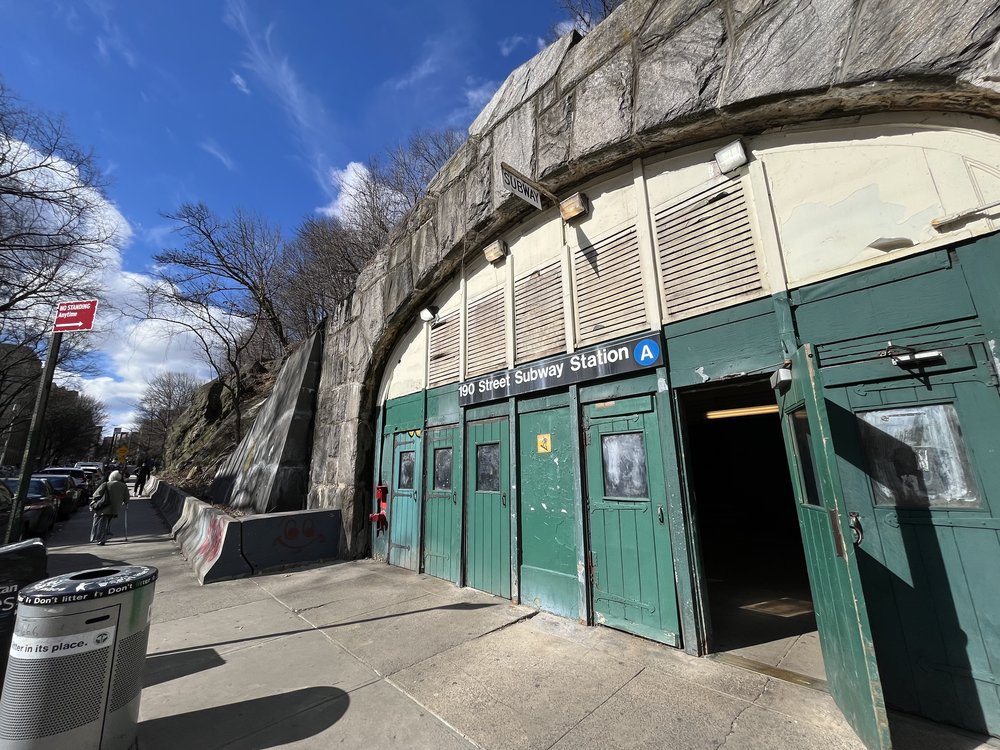Why a Manhattan subway station could be a shelter in a nuclear attack
March 22, 2024, 11:01 a.m.
The 190th Street station on the A line is buried beneath 140 feet of bedrock. It's so deep, in fact, that researchers in 1951 concluded radiation from a nuclear blast would be unlikely to reach the station.

This column originally appeared in "On The Way," a weekly newsletter covering everything you need to know about NYC-area transportation.
Sign up to get the full version, which includes answers to reader questions, trivia, service changes and more, in your inbox every Thursday.
In the event of nuclear attack, you may be safe in Washington Heights’ 190th Street subway station
The 190th Street A train station in Washington Heights is buried so deep underground it could act as a fallout shelter in the case of a nuclear attack.
Or at least that’s what Dr. Morris Shamos, an NYU physics researcher, concluded in 1951. He’d conducted tests using cosmic rays that determined "radiation from an atomic bomb would be extremely unlikely to reach the station," the New York Times reported.
"On The Way" stumbled across Shamos’ study while reporting on the MTA’s plan to finally renovate the 190th Street station, which has paint coming off the walls and chipped ceilings. The station is buried beneath 140 feet of bedrock at Fort Tryon Park. It takes a 30-second elevator ride to move between its upper entrance and mezzanine.
Around the same time as Shamos’ study, city officials looked into using subway stations in Washington Heights like 190th Street and the even deeper 191st Street station as potential fallout shelters. The Board of Transportation at the time also pitched building shelters inside the planned — but never built — Second Avenue subway. The survey came a year after the Soviet Union successfully tested its first atomic weapon, ushering in a new chapter of the Cold War.
City officials at the time proposed fitting out deep underground stations with shelter rooms that had plumbing, pantries and first aid kits. But those plans were shelved due to a lack of federal funding.
MTA officials did not answer questions about whether those subway stations could serve as fallout shelters in a pinch. But the agency did say transit officials have participated in workshops that determined subway stations aren’t ideal for a long term stay because they lack access to food and water.
The most recent guidance from the city about what to do during a nuclear attack did not mention the subways. In 2022, the city released an eyebrow-raising public service announcement directing New Yorkers to shelter indoors, away from windows “if the big one has hit." After the announcement sparked some alarm, Mayor Eric Adams explained it “was right after the attacks in the Ukraine and OEM (the Office of Emergency Management) took a very proactive step to say let's be prepared.”
This week in New York City transit news
Listen here:
- MTA outreach teams are involuntarily hospitalizing homeless people with signs of mental illness. Since the program launched roughly three months ago, SCOUT teams have sent at least 15 people to the hospital involuntarily for a psychiatric assessment. Gothamist rode along for a shift. Read more.
- At a tense City Council hearing this week, top NYPD officials argued that increased law enforcement has kept the subway system safe, while some councilmembers questioned whether stepped-up policing and the presence of National Guard soldiers are actually deterring crime. Read more.
- Terrified passengers trying to flee Brooklyn's Fulton Street station after a recent shooting on an A train were forced to leave single file because an emergency exit door wouldn’t open, multiple riders told Gothamist. Read more.
- Four shootings have now taken place in the subway system since the start of 2024. We put together a timeline. Read more.
- The city’s transportation department is launching a multilingual e-bike public safety campaign in response to a soaring number of deadly crashes on the bikes. Read more.
- Renovation work at an MTA subway ventilation plant on the Lower East Side has turned a once bustling street next to a park into a noisy construction site that’s become a haven for drug use for more than five years — and neighbors say there’s no end in sight. Read more.
- According to an internal MTA document, the agency collected 25,628 comments in its final round of congestion pricing public input sessions — and positive comments outnumbered anti-toll comments by about 2 to 1. (Streetsblog)
- “A lot of us had dreams of having a career with the MTA,” said one 21-year-old Brooklynite who’s among a group of transit aficionados who break into out-of-service subway cars and take them for little joyrides. (Curbed)
Curious Commuter
Question
Will we get a subway line to LaGuardia Airport?
– Chrisostomos, Nassau County
Don’t count on a train of any kind to LaGuardia Airport. Gov. Kathy Hochul last year announced the Port Authority would move ahead with a plan to boost bus service to the Queens airport, adding more priority routes for the Q70 bus from Jackson Heights and establishing a new nonstop shuttle route from the Astoria Boulevard subway station on the N and W lines. Former Gov. Andrew Cuomo had previously championed a plan to build an AirTrain to LaGuardia for $2.1 billion. The project would have required riders to transfer and pay a second fare at Willets Point. Hochul nixed that plan shortly after she took office in 2021.
MTA will spend $100M to revitalize 2 grimy, historic NYC subway stations